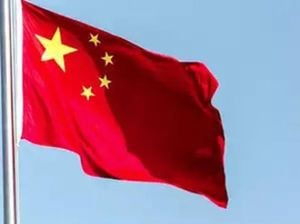Indian equity markets are bracing for a turbulent week ahead, with investors’ nerves rattled by a mix of escalating trade tensions with the United States and the impending release of crucial domestic inflation data. The mood is cautious—as it should be, given the recent string of declines and the uncertainty swirling around both international and domestic fronts.
According to MENAFN, both the BSE Sensex and NSE Nifty suffered their sixth consecutive week of losses, with the Sensex falling 1.01 percent to close at 79,857.79 and the Nifty shedding 1.20 percent to settle at 24,363.30 as of Friday, August 8, 2025. The sharpest blow to sentiment came after U.S. President Donald Trump announced a sweeping 50 percent tariff on Indian goods—a move that sent shockwaves through export-focused sectors and left investors scrambling to reassess their positions.
Ajit Mishra, Senior Vice President - Research at Religare Broking Ltd., told MENAFN, “The dominant driver of the week's decline was the sudden escalation in US tariffs. Near-term market direction will be shaped by clarity on US tariff implementation, India's diplomatic response, and incoming inflation readings.” His words capture the mood perfectly: investors are watching, waiting, and—at least for now—hesitating.
The impact of the tariffs was felt most acutely in the pharma and IT sectors, which have significant exposure to the U.S. market. Foreign institutional investors (FIIs) were net sellers throughout the week, unloading shares in these sectors and further amplifying the downward pressure. Vinod Nair, Head of Research at Geojit Financial Services, observed, “The Indian equity market exhibited downward movement, closing at a three-month low amid growing concerns over the impact of U.S. tariffs on Indian exports.”
Adding to the complexity, the Reserve Bank of India (RBI) decided to keep the policy repo rate unchanged at 5.50 percent, maintaining a neutral stance. While this was hardly a surprise, it did little to lift spirits on Dalal Street. The RBI’s steady hand may provide some comfort, but with so many unknowns on the horizon, it’s clear that investors are more interested in what comes next than in what’s staying the same.
All eyes are now on the upcoming release of India’s Consumer Price Index (CPI) and Wholesale Price Index (WPI) inflation data for July. These figures could provide much-needed direction in a market that’s been buffeted by external shocks and policy uncertainty. Meanwhile, the earnings season is winding down, but a handful of heavyweight results—from Ashok Leyland, ONGC, IOC, Hindalco Industries, and BPCL—are expected to trigger stock-specific moves in the coming week.
Siddhartha Khemka, Head of Research - Wealth Management at Motilal Oswal Financial Services, summed up the prevailing sentiment: “Overall, we expect equities to remain in consolidation mode until there is clarity on the tariff front. In this volatile environment, investors may focus on domestic-oriented themes, while traders are advised to keep positions light.” It’s a strategy born of necessity, not optimism.
But the uncertainty on the trading floor is just one part of a much larger story about how India is navigating the choppy waters of global perception and economic measurement. As Priyal Bhardwaj, founder of Sangini Saheli and general secretary of the women’s wing of the BJP in New Delhi, writes in her recent piece, India’s standing in the world isn’t just about market indices—it’s also about how the country is ranked, rated, and understood by international organizations and rating agencies.
NITI Aayog, India’s premier policy think tank, has been at the forefront of developing a range of performance indices that cover everything from innovation and water management to fiscal health and poverty. These tools have fostered healthy competition among Indian states, shaped policy decisions, and increased transparency and accountability. Yet, on the global stage, India has seen its rankings slip in several international indices, especially those that rely on subjective assessments—such as democracy, press freedom, and civil liberties.
Over the past decade, India’s decline in perception-based indices has become a matter of national debate. In early 2021, the government set up a committee of secretaries to monitor and improve India’s performance on key global benchmarks. By November 2022, the Economic Advisory Council to the Prime Minister had released a report scrutinizing India’s low rankings in three major opinion-based indices: Freedom in the World, the EIU Democracy Index, and the Varieties of Democracy project.
By April 2025, the government was actively reviewing the methodologies of 28 global indices—including those assessing democracy and hunger—paying particular attention to sample sizes and modelling techniques. The recurring issue, as Bhardwaj points out, is the reliance on the opinions of small groups of unnamed experts. “For example, the Democracy Index has ranked India at 104, while other countries with questionable recent democratic records have fared significantly better—raising questions about the consistency and contextual understanding of these rankings,” she writes. The Press Freedom Index, which once placed India below Afghanistan, is another example that has drawn widespread criticism for its perceived lack of realism.
It’s not just about democracy and press freedom. A recent Reuters article, cited by Bhardwaj, questioned the credibility of India’s official unemployment data based on a perception-based survey of around 50 anonymous economists. The government’s response focused on the lack of methodological transparency and the dangers of interpreting complex economic data through a narrow, subjective lens.
The stakes are high. These indices feed into broader metrics like the World Governance Indicators (WGI), which influence sovereign credit ratings and, by extension, the cost of borrowing for countries like India. With Environmental, Social, and Governance (ESG) metrics and Artificial Intelligence systems increasingly drawing on these datasets, there’s a real risk that flawed indices could entrench systemic biases and misrepresent the realities on the ground.
Bhardwaj advocates for a proactive approach: “Looking ahead, it is vital for the government to actively engage with institutions that compile global indices and demand the updation of their processes and contextualisation of the parameters.” She suggests that constructive dialogue—not outright dismissal—is the key to ensuring fairer evaluations. At the same time, she calls on Indian think tanks and academic bodies to develop their own metrics and present alternative frameworks that reflect local realities.
There are signs of progress. In October 2024, CareEdge Global became the first Indian agency to launch sovereign credit ratings for global economies, a move widely seen as a step toward greater transparency and the inclusion of diverse perspectives in global assessments. It’s a milestone that signals India’s determination to shape its own narrative, rather than simply reacting to the judgments of others.
As Indian investors and policymakers navigate a week of market volatility and global scrutiny, the message is clear: the country’s fortunes are tied not only to the numbers flashing on trading screens, but also to the narratives that shape how the world sees India. In this environment, both caution and creativity are required—on the trading floor and in the halls of policy.
With so much at stake, the coming days will test not just the resilience of Indian markets, but the country’s ability to engage, adapt, and assert its story on the global stage.



